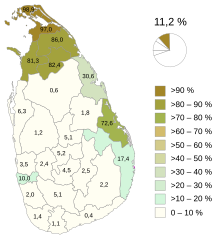Sri Lankan Tamils
The native Tamil population of Sri Lanka is referred to as Sri Lankan Tamils ( Tamil : இலங்கைத் தமிழர் Ilaṅkait Tamiḻar [ ˈilaŋɡɛi̯ t̪ːamɨɻər ]; also Eelam Tamils , Tamil: ஈழத் தமிழர் Īḻat Tami ) ar [ ˈɨːɻə t̪ːamɨɻər ]) . The largely Hindu Sri Lankan Tamils form the largest ethnic minority of the island state, the majority of which is inhabited by Buddhist Sinhalese . The Sri Lankan Tamils are to be distinguished from two other Tamil-speaking minorities in Sri Lanka: theIndian Tamils who immigrated as plantation workers during colonial times in the 19th and 20th centuries, and the Tamil-speaking Muslims known as Moors .
Demographics
According to the 2012 census, almost 2.3 million Sri Lankan Tamils live in Sri Lanka, which makes up 11.2 percent of the total population. Your settlement area includes the north and east of the island. In the Northern Province they make up the vast majority of the population, in the Eastern Province a relative majority alongside Moors and Sinhalese . There are also Sri Lankan Katamil minorities in other parts of the country such as the capital Colombo . As a result of the civil war, there is a large Sri Lankan Katamil diaspora outside of Sri Lanka. The largest communities live in Canada , Great Britain , France , Germany and Switzerland .
Around 80 percent of the Sri Lankan Tamils are Hindus , there is also a Christian (mostly Catholic ) minority. The native Tamil-speaking Muslims , unlike the Tamil Muslims in India, do not identify as Tamils, but are considered a separate ethnic group, called Moors. The dialects of Tamil spoken by the Sri Lankan Tamils are quite different from the Indian dialects and are mainly characterized by the preservation of ancient features that have been lost on the mainland.
history
Immigration of Tamils from South India to Sri Lanka seems to have taken place in prehistoric times. The earliest epigraphic evidence of a Tamil presence in Sri Lanka dates back to the 2nd century BC. The Mahavamsa , a Sinhalese chronicle, reports that in 145 BC A Tamil general from South India named Elara usurped the throne in Anuradhapura and ruled for 45 years until he was defeated by the Sinhalese King Dutthagamani .
Since the 5th century, the Tamil kingdoms of southern India expanded their sphere of influence several times to Sri Lanka. In the 11th century, the Tamil Chola dynasty finally conquered Sri Lanka and ruled the entire island until it was driven out by King Vijayabahu I in 1070 . There appears to have been a large Tamil immigration movement to Sri Lanka during the Chola rule. In 1215 the Tamil Kingdom of Jaffna was established in the north of the island, which remained independent until the Portuguese conquered in 1619.
Since Sri Lanka's independence from Great Britain in 1948, the conflict between the Sinhalese and Tamils has steadily intensified. Strong ethnic and political tensions, followed by pogroms in 1958, 1977, 1983 and 1987 led to the establishment of militant groups aiming for an independent Tamil state of Tamil Eelam . The resulting civil war has cost the lives of more than 70,000 people to date. Since its inception, nearly a million Tamils have also fled to India, Canada and Europe.
Individual evidence
- ^ Department of Census and Statistics Sri Lanka: Population by ethnic group according to districts, 2012 .
